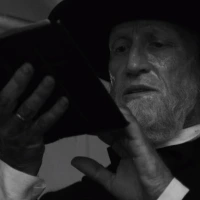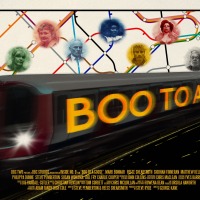 Eureka, out June 14, 2021
Eureka, out June 14, 2021
A concert pianist loses his hands but their replacements carry a particular burden…
The first movie version of Maurice Renard’s serialised novel reunites the director and star from The Cabinet Of Dr Caligari, with director Robert Wiene perhaps having more to prove than star Conrad Veidt, as he had at the time not been quite so lauded for the previous film as Veidt and the art department had been.
The plot, taken from the last few chapters of the novel, is by now familiar from many remakes: concert pianist Orlac loses his hands in a train crash, but they are replaced with a pair of working hands taken from the corpse of an executed murderer. Soon, Orlac’s already fragile mental state is being called into question, he can’t bear to touch anyone, and his father is murdered… Could the hands have a will of their own? Most later adaptations actually go with the simpler and more melodramatic answer to that, but this one came first, and so gets away with a more original and faithful to the novel (as far as that can be achieved, considering that this element is such a small part of the novel) resolution than other versions.
As a film, it’s a little slow, but a great insight into a troubled mind, with added crime, superficial supernatural elements, and a subtext of psychology and medical science which at the time was realistic science fiction. Renard, after all, viewed himself as a futurist and SF writer akin to HG Wells, rather than as a horror or thriller writer, and that’s reflected well in this film. Though commonly viewed as a horror film it’s actually more a psychological study of a man with PTSD from the circumstances of his injury (something that would have been clear to audiences of the time, bearing in mind that the First World War had taken place entirely within a decade prior to the making of the film, and had ended only two years before the novel was written.)
Wiene’s Caligari, four years earlier, had given cinema the bloom of the Expressionist style, and made Veidt a star, but by the time of Orlac the Expressionist style had evolved; it had been taken abroad by various directors, and begun to evolve into what would become (by way of Fritz Lang’s M and its influence in Hollywood) the Noir style. Hands of Orlac itself really brings us a blend of Expressionism (the Orlac home, the sequences of Felix Kortner’s introduction as the villain), Noir (femmes fatale and the speeding car in the headlights, Cinema verité (the crash site, prefigured newsreels of the Blitz), and even English Gothic (notable in the shots of the car carrying Orlac along a tree-lined road, which would fit in any MR James style of show.
The cast are good, with Veidt’s mind-boggling muscular control, and Felix Kortner’s villain, Nera, being particular standouts. You either love or hate silent movie acting, but the key thing is to remember the context; nobody can use their voice, and a lot of it is stage acting, or experimenting to see what works. Wiene’s direction is also good, reminding us that he was a major factor in Caligari’s success even if he wasn’t recognised for it at the time, but if the film has a downside it’s in the plot itself; cherry-picking from its source novel, we’re left trying to work out why, for example, a retiring pianist is so concerned about not being able to play again after his farewell concert. Nera’s plan is also ludicrously over-complicated and unbelievable.
In fact for the first chunk of the movie, it’s neither Orlac nor Nera who is the main character, but the relatively understated Yvonne Orlac, played by Alexandra Sorina, who had starred with Veidt in Rasputin Damon Des Frauen. She and Kortner have what are often said to be the more interesting roles – and those who think Paul Orlac is dull and annoying should bear in mind this film has the least annoying title character of all the filmed versions, none of whom are as irritating as the novel’s! – so they have material to get their teeth into, while Veidt has to pretty much make his own. What he does, however, is express the internal state of a character mired in the effects of PTSD.
As mentioned earlier, the story has been adapted many times, but this Blu-Ray release brings us two different versions of Wiene’s film. The main feature is a nice and crisp restoration and reconstruction of (mostly) the original 1924 theatrical release, which runs 93 minutes (new distributor credits slightly lengthen this from the original 92). This version has the original German intertitles, with Englsh subtitles to translate them, but these subtitles do sometimes overlay the intertitles, occasionally obscuring both. The print is very much crisper than the other version on the disc – the longer Kino-Lorber DVD version from 2011 – with a lot of the damage cleared up. That said, given the age and varying sources of the film elements involved, all of it is somewhat speckly and hit by damage marks.
The Kino-Lorber “alternate presentation” is also worth watching, despite being less cleaned up, and merely an upscale SD presentation of the 2011 DVD. It’s going to be more easily available here, and is a longer cut, by about 15 minutes. This version has a little more Veidt, fewer removed frames, some nice alternate takes, and English intertitles. That said, it’s a little grubbier, has a far more annoying score with slowed down vocal groans, and more sequences broken up in a confusing manner, such as leading to the crash, and the scene where Orlac confronts the doctor about whether the hands came from a murderer. A number of shots are also clearly the full take from camera start to stop, making for longer sections of nothing. The three-times-longer shot of the car going along the ridge of trees springs to mind here.
This newly restored cut, which has been doing the silent film festival rounds for a couple of years now, also rearranges several scenes, making them flow better and make more sense – especially in the early part of the film, fixing the chronology of the train crash and who is where – but sadly it doesn’t change all the scenes that need such treatment. There are also some sequences, such as when Paul Orlac first gets out of bed in hospital and collapses, where a few frames have been trimmed out of whichever source print has been used, giving a juddering effect. It’s difficult to tell whether these instances have been to remove the most damaged frames, or give a surrealist or nightmarish vibe, or what.
The restoration features a commentary by the ever-reliable Kim Newman, accompanied by Stephen Jones. This commentary is a mixed bag: Kim Newman is good fun and hugely informative, but Stephen Jones appears to think he’s talking about the inventor of women’s depilatory tech as he keep going on about some guy called “Veet”. He also seems to think Connie is a horror actor who should have been (type)cast as the blackmailer in this. And he keeps getting stuff wrong and being corrected by Kim. Overall, though, the commentary seems to lean more towards talking about the original novel, and its author and adaptations, with diversions into other vintage movies.
There’s also a “version comparison” feature, but this is from the Kino DVD and compares its restoration to a previous 1995 version, not comparing the new restoration to the Kino one. Better value is the “Extremities” documentary produced for this disc. Written by Fiona Watson and David Cairns, this is narrated by Jessica Martin – the only person on the disc to pronounce Veidt’s name absolutely correctly – this, like much of the commentary, talks as much about Renard and other versions of the story as about this movie, and contains plenty of fascinating clips from other versions and other Wiene and/or Veidt movies. It does offer a strangely binary reading of the truth of Orlac’s mentality; possessed by the hands, or secretly murderous himself, without examining the PTSD side or the possibility of him suffering a brain injury. (Anger flashes and suchlike are the most common side effect of Traumatic Brain Injury, and Orlac does have a skull fracture as well- and Veidt plays to that well too.)
Throw in an informative booklet from Philip Kemp and Tim Lucas, and you have a marvellous and fascinating package.
Verdict: This is an excellent movie, but probably not the one you think it is on account of later remakes. This Masters Of Cinema release is an essential purchase for fans of the development of horror tropes (even though it didn’t invent the evil hand trope, it brought it to public consciousness), of silent cinema, or thrillers, of the cinematic representation of mental health effects, of Conrad Veidt or Robert Wiene… The new version is as close to seeing it brand new in 1924 as is possible without time travel. There’s lots of information about the subjects in hand, as it were, and while both it and the Kino cut have slightly different problems with clarity and flow, having both in the one set is an unmissable opportunity. Even if you already have the Kino disc, this would only drop one point. Excellent stuff, and full applause to Eureka and Masters Of Cinema. 10/10
David A McIntee
Click here to order from Amazon.co.uk











 Eureka, out June 14, 2021
Eureka, out June 14, 2021